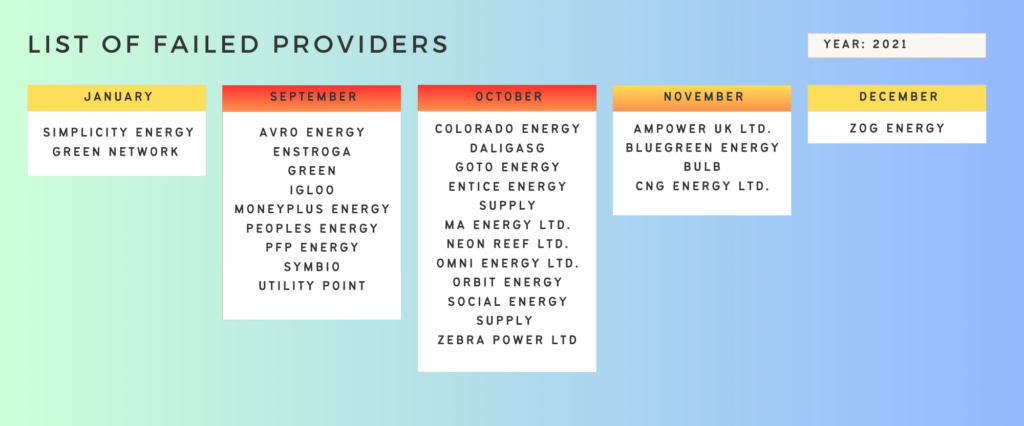The energy cost is still causing much anxiety and stress for many people and businesses more than two years after the initial crash. Many consumers are still looking to switch power supplier, but most switching services are on hold.
The demand for switching energy providers will remain significant in 2024. However, due to a substantial number of energy suppliers going out of business in recent years, the surviving ones must cater to this demand. In 2022, the UK energy market encountered difficulties, resulting in a decrease in the availability of switching services, as most providers were not accepting new customers. Fortunately, the situation has improved since 2023, offering consumers a more optimistic and economically viable outlook for the future.
The crash
October 2021 started with a substantial increase in the average household level from £1,138 to £1,277, with a 50% increase in the price of gas. Over the winter months, brits were left with little support with the “Heat now, pay later” loan program.
Things went from bad to worse at the end of February 2022 when Russia invaded Ukraine, further skyrocketing the wholesale gas price. Only one month later, the Ofgem Price Cap increased by a staggering 54%, which, according to the National Energy Action estimations, left 6.5 million households in fuel poverty.
The crisis led to the collapse of a record number of energy suppliers, leaving millions of customers and businesses without a supplier. Before the market crash, you could’ve solved this in minutes by contacting an energy provider or scouting the internet for the next best energy deal. However, by October 2021, switching power providers became an impossibility due to the overwhelming state of the energy market, which could not accommodate any new customers.
List of power suppliers that collapsed in 2021

These collapses affected nearly four million households in the UK. However, no households faced a disruption thanks to the Supplier of Last Resort (SoLR) process established in 2003. This means that if your energy provider goes out of action, you automatically switch power supplier.
The collapse of so many power suppliers in such a short period of time highlighted the fragility of the UK energy market. The government has since taken steps to strengthen the market, such as increasing the minimum capital requirements for energy suppliers.
A slow comeback
The energy market in the UK started to recover from the 2021 crisis in early 2023. If you recently went through any of the big service comparison platforms in the UK to switch your energy suppliers, chances are you’ve encountered a message saying that this service is temporarily unavailable.
The government took a number of steps to address the crisis, including increasing the minimum capital requirements for power suppliers and introducing the Energy Price Cap. The Energy Price Cap limits the amount that energy suppliers can charge their customers for their standard tariffs.
These measures have helped to stabilise the energy market and prevent further collapses of power suppliers. However, the market is still vulnerable to shocks, such as the global energy crisis.
There are a number of signs that the energy market is starting to recover. For example, the number of energy suppliers offering new tariffs has increased, and the Energy Switch Guarantee is being improved. However, it will likely take some time for the switching market to return to pre-crisis levels.
Consumers can help to support the energy market by switching to a more competitive tariff. They can also help to reduce their energy consumption by making energy efficiency improvements to their homes.
How to switch energy supplier in 2023: Tips from TOP Energy Experts
This year presents a unique chance to seize the reins of your energy expenses and embark on a journey towards savings and sustainability. In this rejuvenated energy landscape, switching providers emerge as a powerful recommendation, a gateway to securing a better deal and harnessing the benefits of a market poised for resurgence. Let’s delve into why 2023 is the ideal time to consider a change, explore the advantages of switching, and guide you towards a brighter and more economical energy future.
1. Regularly Compare Tariffs:
Energy tariffs can change frequently. Industry experts recommend comparing energy tariffs at least once a year to ensure you’re getting the best deal. Use online comparison tools to find and compare offers from different suppliers easily.
2. Consider Fixed or Variable Tariffs Carefully:
Experts suggest considering your energy usage and budget when choosing between fixed and variable tariffs. Fixed tariffs offer price stability, while variable tariffs may fluctuate with market conditions.
3. Check for Exit Fees:
Before switching, review your current energy contract for any exit fees. These fees can offset potential savings from switching, so knowing what you might incur is essential.
4. Evaluate Customer Service:
Besides price, consider the quality of customer service potential energy suppliers provide. Look for reviews and ratings to gauge the level of customer satisfaction with each company.
5. Explore Green Energy Options:
In 2023, there’s a growing focus on environmentally friendly energy. Experts recommend considering suppliers that offer renewable energy options to reduce your carbon footprint.
6. Understand Your Usage:
Industry experts emphasize the importance of understanding your energy usage patterns. This knowledge will help you choose a tariff that suits your consumption and lifestyle.
7. Timing Matters:
Keep an eye on the energy market. Experts suggest that the best time to switch may vary, but looking for deals during the off-peak season or when suppliers offer promotions can lead to significant savings.
8. Be Wary of Dual Fuel Discounts:
Some suppliers offer discounts if you combine gas and electricity with them. Experts recommend calculating if these discounts genuinely save you money or if separate tariffs for gas and electricity are more cost-effective.
9. Read the Fine Print:
Before committing to a new supplier, carefully read the terms and conditions, including the length of the contract and any special terms. Make sure you understand what you’re signing up for.
10. Don’t Be Afraid to Haggle:
Expert advice often includes negotiating with your current supplier for a better deal. If you’ve found a better offer elsewhere, let your current supplier know; they may match or even beat the offer to retain your business.
11. Switch Energy Supplier Responsibly:
Lastly, industry experts encourage consumers to switch energy supplier responsibly. Ensure your chosen energy provider aligns with your values and preferences, whether it’s about green energy, customer service quality, or other ethical considerations.
FAQ
[accordions id=’6279′]

